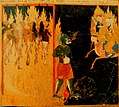Zabaniyya
In Islam the Zabaniyya (Arabic: الزبانية) (also spelled Zebani in Turkish language) are the forces of hell,[1] who torment the sinners, also called the Angels of punishment or Guardians of Hell.[2] They are often identified with the Nineteen Angels of Hell mentioned in Quran 66:6 and 74:30 or as their subordinates.[3] Namely they appear in Surah 96:18. In art, they are pictured as horrifying demons.[4] Prior to the anglification of the Zabaniyya, they were probably thought as a kind of demon.[5] Al-Mubarrad relates them to Afarit, a type of underworld demon still prevailing in later Islamic thought. He states that Afarit are sometimes referred to as "ʿifriyya zibniyya", "ZBN" denoting "pushing back" as their characteristic action.[6]
In Turkish language, the term is also referred to that is called hellhound or hellbound demons in English language.[7]
Etymology
The word Zabaniyya may have been derived from the syriac shabbāyā, used to describe angels who conduct the souls of the dead or as frightening demons. Another suggestion attributes the origin to rabbāniyya referring to the lords angelic council.[8] Further Zabaniyya may refer to a class of Arabian demons.[9] According to a recent etymological suggestion, this term may derived from Sumerian zi.ba.an.na ("The Scales") and Assyrian zibanitu meaning scorpion. Thus, it is suggested that Zabaniyya are originally astrological figures with their lord Maalik symbolizing the Mars, that reigns the "scorpion" in the astrological imaginations. On the other hand, nineteen Zabaniyya also originated from astrological map. In ancient concept, the seven planets and twelve astral houses together corresponded to the number nineteen.[10] Al-Mubarrad suggested, zabāniya could derive from the idea of movement and the Zabaniyya are those who "push somebody [back]".[11]
Gallery
References
- ↑ Hans Wilhelm Haussig, Egidius Schmalzriedt Wörterbuch der Mythologie Klett-Cotta 1965 ISBN 978-3-129-09870-7 page 314 (german)
- ↑ Stephen Burge Angels in Islam: Jalal Al-Din Al-Suyuti's Al-Haba'ik Fi Akhbar Al-mala'ik Routledge 2015 ISBN 978-1-136-50474-7 page 277
- ↑ Hajjah Amina Adil Muhammad the Messenger of Islam: His Life & Prophecy BookBaby 2012 ISBN 978-1-618-42913-1
- ↑ Sheila Blair, Jonathan M. Bloom The Art and Architecture of Islam 1250-1800 Yale University Press 1995 ISBN 978-0-300-06465-0 page 62
- ↑ Lange, Christian. “Revisiting Hell’s Angels in the Quran.” Locating Hell in Islamic Traditions edited by Christian Lange, Brill, LEIDEN; BOSTON, 2016, p. 79 JSTOR, www.jstor.org/stable/10.1163/j.ctt1w8h1w3.10.
- ↑ Lange, Christian. “Revisiting Hell’s Angels in the Quran.” Locating Hell in Islamic Traditions edited by Christian Lange, Brill, LEIDEN; BOSTON, 2016, p. 82 JSTOR, www.jstor.org/stable/10.1163/j.ctt1w8h1w3.10.
- ↑ https://www.almaany.com/en/dict/en-tr/zebani/
- ↑ Christian Lange Paradise and Hell in Islamic Traditions Cambridge University Press 2015 ISBN 978-1-316-41205-3 page 65
- ↑ Christian Lange Paradise and Hell in Islamic Traditions Cambridge University Press 2015 ISBN 978-1-316-41205-3 page 52
- ↑ Gürdal Aksoy, On the Astrological Background and the Cultural Origins of An Islamic Belie: The Strange Adventures of Munkar and Nakir from the Mesopotamian god Nergal to the Zoroastrian Divinities, https://www.academia.edu/35372440/On_the_Astrological_Background_and_the_Cultural_Origins_of_An_Islamic_Belief_The_Strange_Adventures_of_Munkar_and_Nakir_from_the_Mesopotamian_god_Nergal_to_the_Zoroastrian_Divinities_Mezopotamyal%C4%B1_Tanr%C4%B1_Nergal_den_Zerd%C3%BC%C5%9Fti_Kutsiyetlere_M%C3%BCnker_ile_Nekir_in_Garip_Maceralar%C4%B1_
- ↑ Lange, Christian. “Revisiting Hell’s Angels in the Quran.” Locating Hell in Islamic Traditions edited by Christian Lange, Brill, LEIDEN; BOSTON, 2016, p. 82 JSTOR, www.jstor.org/stable/10.1163/j.ctt1w8h1w3.10.



